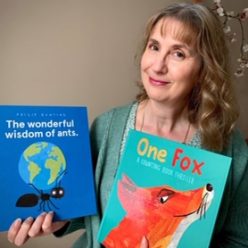Illustrated by the author

Published by Abrams Books for Young Readers, London, 2011
David Attenborough recently celebrated his 94th birthday and for one whose life has been all about the conservation, protection and exploration of the natural world and its biodiversity, it would seem remiss not to quote him saying something both wise and wonderful when reviewing a picture book that considers these themes:
“The truth is: the natural world is changing. And we are totally dependant on that world. It provides our food, water and air. It is the most precious thing we have and we need to defend it.”
Alex Beard has also travelled extensively to some of the most remote places on earth, painting and reflecting on the interconnections between environments, wildlife and people. Crocodile Tears is the third book in the Tales from the Watering Hole series which also includes The Jungle Grapevine and Monkey See Monkey Draw. Proceeds from the sale of Crocodile Tears go to the Shompole Community Trust, which is a land and animal reserve in Kenya overseen by the Maasai people.
The setting for this story is Africa, near the Mburu River. Rhino and Tickbird are coming to the river to drink and want to know why crocodile is crying, but they are afraid to approach a mouth full of teeth, so who can they ask? Off they go to explore the African plains looking for animals that might know the answer.
What I most admire about the way the story unfolds is that each creature who is asked and does not know the answer, suggests another creature by describing something remarkable and unique about them. The Golden Eagle recommends asking the Elephant whose trumpeting can be heard for miles; the Elephant suggests asking the tree frogs whose song is so beautiful; the tree frog proposes asking the butterfly whose wing patterns are so dazzling. And there are many more encounters just like this.
The animals however are proving difficult to find, and that message is often repeated. Could it be that is why the crocodile is crying? Perhaps it is because all the animals are disappearing.
Finally, after a humorous encounter with an ostrich, Rhino and Tickbird find their courage and ask Crocodile why he is crying. The answer is very clever.
“I’m crying because it is hot in the sun and the tears keep my eyes moist and healthy. It’s one of the things crocodiles do. But, since you asked Black Rhino, it could be because I am going to miss you.”
Well, if you are like me, I thought the message was about extinction.
But no, the crocodile actually eats Rhino!
Not to worry, crocodile spits Rhino out again!
But…the message is about extinction. Some of the animals mentioned in the picture book are critically endangered. Their habitats are under threat, they are at risk of poaching and hunting, and sometimes cannot find enough food.
A glossary at the end of the book gives some insight into these problems and there is a small paragraph with an accompanying photo giving the reader information about habitat, population numbers and conservation efforts.
I can highly recommend this book for children 4-8 years, it can help young readers begin to understand the complex nature of conservation and how people can play a vital role in the protection of animal species. Here are more suggestions for further reading:

by Emily Bornoff

by Diane Jackson Hill
Illustrated by
Craig Smith

by Rohan Cleave
and Coral Tulloch

by Martin Jenkins
Illustrated by
Vicky White

by Mordicai Gerstein

Paul Meisel

Jess Keating
Illustrations by Marta Alvarez Miguens

Illustrated by Rachel Qiuqi


by Sarah Kendell

by Nicola Davies
